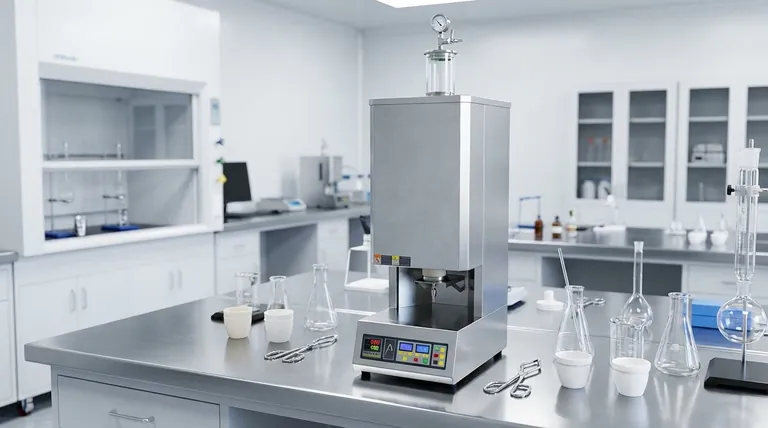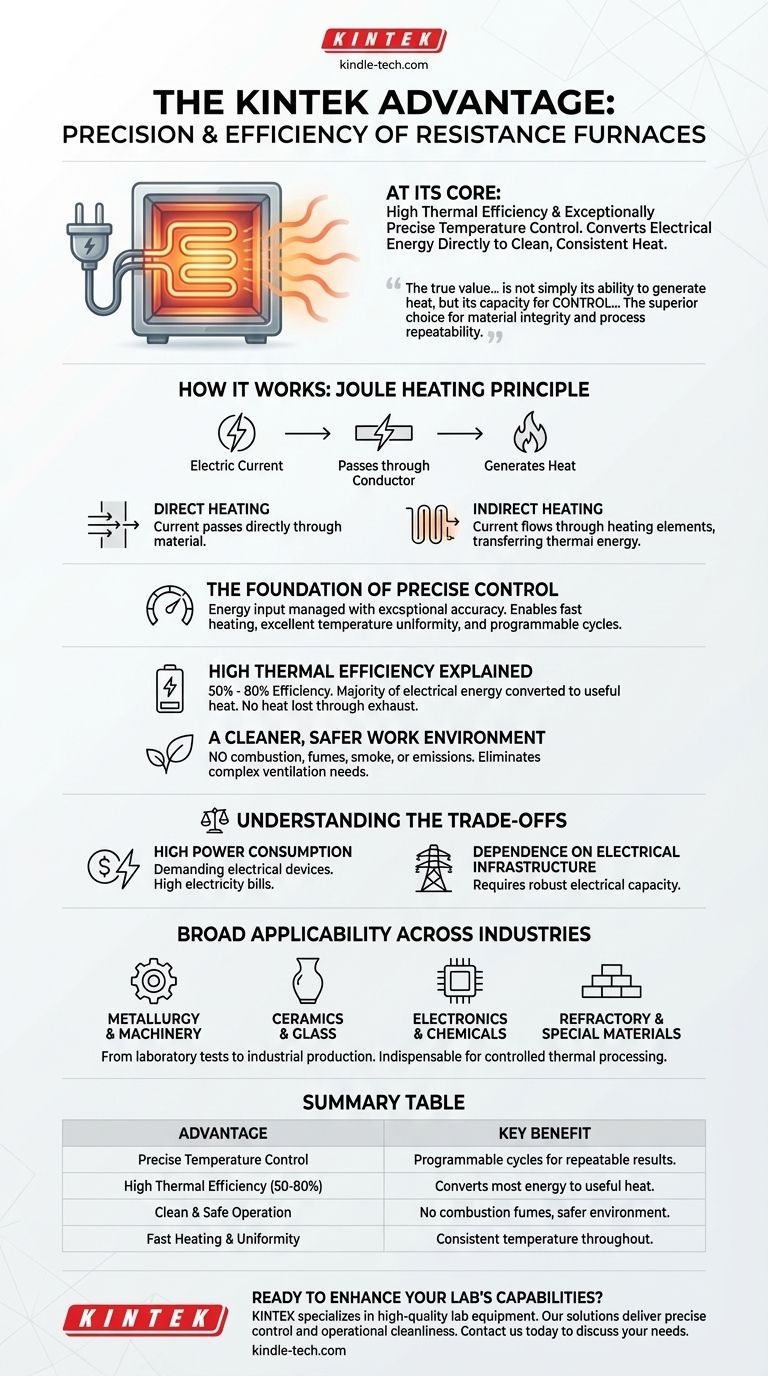At its core, the primary advantage of a resistance furnace lies in its combination of high thermal efficiency and exceptionally precise temperature control. This technology converts electrical energy directly into heat within a contained environment, providing a clean, consistent, and highly manageable heating process suitable for demanding applications.
The true value of a resistance furnace is not simply its ability to generate heat, but its capacity for control. It offers a level of precision and environmental cleanliness that fuel-fired alternatives often cannot match, making it the superior choice for applications where material integrity and process repeatability are paramount.

How a Resistance Furnace Works
To understand its advantages, it's first necessary to understand its fundamental principle. A resistance furnace operates on the concept of Joule heating, where an electric current passing through a conductor generates heat.
The Principle of Direct vs. Indirect Heating
A resistance furnace converts electrical energy into thermal energy. This happens in one of two ways:
- Direct Heating: The electric current passes directly through the material being heated (the "furnace charge"), which itself acts as the resistance element.
- Indirect Heating: The current flows through dedicated electric heating elements. These elements heat up and transfer the thermal energy to the material via conduction, convection, and radiation. This is the more common configuration.
The Foundation of Precise Control
Because the heat source is electricity, the energy input can be managed with exceptional accuracy. This direct relationship between electrical power and temperature output allows for fast heating speeds, excellent temperature uniformity throughout the furnace chamber, and highly programmable heating and cooling cycles.
High Thermal Efficiency Explained
Resistance furnaces boast high thermal efficiency, often between 50% and 80%. This means a majority of the electrical energy consumed is converted directly into useful heat for the workpiece. Unlike fuel-fired furnaces, there is no heat lost through exhaust stacks or combustion byproducts, making the process highly effective at concentrating energy where it's needed.
A Cleaner, Safer Work Environment
The absence of combustion provides a significantly better working environment. There are no fumes, smoke, or greenhouse gas emissions produced during operation. This eliminates the need for complex ventilation and exhaust systems, resulting in a cleaner, quieter, and safer workplace.
Understanding the Trade-offs
No technology is without its compromises. The primary advantages of control and cleanliness come with a significant consideration.
High Power Consumption
While thermally efficient, resistance furnaces are demanding electrical devices. Their operation can result in high electricity bills, and the cost of power is a critical factor in their overall operating expense. The "high efficiency" means little energy is wasted, but the total amount of energy required can still be substantial.
Dependence on Electrical Infrastructure
The high power draw necessitates a robust electrical infrastructure. Facilities must be equipped with sufficient power capacity and appropriate wiring to safely handle the load, which can be a significant consideration for installation and site selection.
Broad Applicability Across Industries
The precise and clean heating provided by resistance furnaces makes them indispensable across a wide range of sectors.
From Laboratory to Production Line
Their versatility allows them to be used for everything from small-scale laboratory tests to large industrial production. A common example is the box resistance furnace, which is a workhorse for general-purpose heat treatment of metal parts, firing ceramics, and conducting material tests.
Key Industrial Uses
These furnaces are widely applied in industries that require controlled thermal processing, including:
- Metallurgy and Machinery
- Ceramics and Glass
- Electronics and Chemicals
- Refractory and Special Materials Development
Making the Right Choice for Your Goal
Selecting a furnace technology requires aligning its strengths with your specific operational needs.
- If your primary focus is process precision and repeatability: The unmatched temperature control of a resistance furnace is ideal for complex heat treatments and sensitive materials.
- If your primary focus is operational cleanliness and safety: The electric, combustion-free nature of a resistance furnace creates a superior work environment.
- If your primary focus is minimizing operating costs: You must carefully balance the furnace's thermal efficiency against the local cost of electricity and the potential need for infrastructure upgrades.
Ultimately, choosing a resistance furnace is a decision for control, quality, and a cleaner process.
Summary Table:
| Advantage | Key Benefit |
|---|---|
| Precise Temperature Control | Enables highly programmable heating cycles for repeatable results. |
| High Thermal Efficiency (50-80%) | Converts most electrical energy directly into useful heat. |
| Clean & Safe Operation | No combustion fumes or emissions; safer work environment. |
| Fast Heating & Uniformity | Provides consistent temperature throughout the chamber. |
Ready to enhance your lab's capabilities with precise and efficient heating?
KINTEK specializes in high-quality lab equipment, including resistance furnaces designed for superior performance in material testing, heat treatment, and ceramics firing. Our solutions deliver the precise temperature control and operational cleanliness your laboratory demands.
Contact us today to discuss how a KINTEK resistance furnace can meet your specific application needs and improve your process efficiency.
Visual Guide

Related Products
- Vertical Laboratory Quartz Tube Furnace Tubular Furnace
- 1400℃ Laboratory Quartz Tube Furnace with Alumina Tube Tubular Furnace
- 1700℃ Laboratory Quartz Tube Furnace with Alumina Tube Tubular Furnace
- Multi Zone Laboratory Quartz Tube Furnace Tubular Furnace
- Laboratory Quartz Tube Furnace Tubular RTP Heating Furnace
People Also Ask
- What is the standard thickness of plating? Optimize Durability, Corrosion & Cost
- What is the difference between upflow and horizontal furnace? Find the Perfect Fit for Your Home's Layout
- What is the process of annealing tubes? Achieve Optimal Softness and Ductility for Your Tubing
- Why does heating increase temperature? Understanding the Molecular Dance of Energy Transfer
- What is quartz tube heating? Achieve Instant, Targeted Heat with Infrared Radiation



















